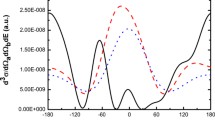Summary
In a previous work we proposed, in the frame of the binary-encounter approximation (BEA) of the inner-shell atomic ionization by ion bombardment, a correction to the ion energy in order to account for the Coulomb repulsion by the atomic nucleus. Such corrected cross-section values numerically coincide with those of the PWBA model, but, as a consequence of the correction, we obtain a much higher-energy ionization threshold than the binding energy, which has no experimental evidence. In the present work we show that ionization below such a threshold can be explained by a double-collision mechanism which involves intermediate electron states and can directly be derived from the impulsive nature of the binary-collision model. Calculations have been performed by supposing a statistical independence between these two collisions. Relativistic corrections have not been taken into account. We have obtained a remarkable agreement between the curves corresponding to single- and double-collision classical processes, since they match at the bombarding threshold ion energy.
Riassunto
Nell'ambito della descrizione del processo di ionizzazione atomica per bombardamento ionico secondo il modello BEA (binary encounter approximation) è stata proposta in un precedente lavoro una correzione all'energia dello ione per tenere conto della repulsione coulombiana da parte del nucleo atomico. La sezione d'urto di ionizzazione cosí corretta coincide in valore numerico con quella del modello PWBA. D'altro canto, questa correzione ha come risultato che si ottiene una soglia di ionizzazione per un valore di energia di bombardamento, molto più grande, dell'energia di legame, che non ha riscontro sperimentale. Nel presente lavoro si mostra come sia possibile spiegara la ionizzazione a energia sotto questa soglia per mezzo di un meccanismo, di doppio urto, che coinvolge stati elettronici intermedi, che discende naturalmente dalla natura impulsive del modello BEA. Il calcolo è stato eseguito nell'ipotesi dell'indipendenza statistica dei due urti e non sono stati presi in considerazione al momento attuale effetti relativistici. Si è ottenuto un notevole accordo fra le curve che rappresentano processi classici di urto singolo e di urto doppio intorno al valore di soglia.
Резюме
В предыдуцей работе мы предпожили, в рамках приближения бинарного соударения для ионизации внутренних оболочек при ионной бомбардировке, поправку к энергии иона, чтобы учесть кулоновское отталкивание атомным ядром. Такие поправленные величины поперечных сечений численно совпадают с результатами модели PWBA. Как следствие этой поправки, мы получаем более высокий энергетический порог ионизации, чем энергия связи, который, однако, не имеет экцпериментального подтверждения. В настояцей работе мы показываем, что ионизация ниже порога может быть объяснена с помощью механизма двойного соударения, который включает промежуточные электронные состояния и может быть непосредственно получен из импульсной природы модели бинарных соударений. Проводятся вычисления, которые предполагают статистическую независимоств межды этими двумя соударениями. В работе не учитываются релятивистские поправки. Мы получаем хороцее согласие между кривыми, соответствуюцими классическим процессам одинарного и двоиных соударений, так как они находятся в соответствии при пороговой энергии бомбардируюцего иона.
Similar content being viewed by others
References
M. Gryzinski:Phys. Rev.,138, 336 (1965).
E. Gerjuoy:Phys. Rev.,148, 54 (1966).
M. Kamiya, K. Ishii andS. Morita:Phys. Rev. A,16, 2295 (1977).
J. S. Hansen:Phys. Rev. A,8, 822 (1973).
P. A. Amudsen, L. Kocbach andJ. M. Hansteen:J. Phys. B,9, L203 (1976);P. A. Amudsen andL. Kocbach:J. Phys. B,9, 971 (1976).
D. Jamnik andC. Zupancic:K. Dan. Vidensk. Selsk. Mat. Fys. Medd.,31, No. 2 (1957);J. M. Bang andH. M. Hansteen:K. Dan. Vidensk. Selsk. Mat. Fys. Medd.,31, No. 13 (1959).
C. Magno, M. Milazzo, C. Pizzi, F. Porro, A. Rota andG. Riccobono:Nuovo Cimento A,54, 277 (1979).
G. Basbas, W. Brandt andR. Laubert:Phys. Rev. A,7, 983 (1973).
G. Basbas, W. Brandt andR. H. Ritchie:Phys. Rev. A,7, 1971 (1973).
G. M. Temmer andN. P. Heydenburg:Phys., Rev.,93, 351 (1954).
K. Adler, A. Bohr, T. Huus, B. Mettelson andA. Winther:Rev. Mod. Phys.,28, 432 (1956).
R. Anholt:Phys. Rev. A,17, 983 (1978).
M. Milazzo, A. Rota andG. Riccobono: Report EUR6492EN, J.C.R. Ispra (1979).
L. Schiff:Quantum Mechanics, 3rd. ed (New York, N. Y., 1968).
Author information
Authors and Affiliations
Additional information
Первебено ребакцией.
Rights and permissions
About this article
Cite this article
Avaldi, L., Magno, C., Milazzo, M. et al. Search for a double-collision mechanism as a possible interpretation for ionization by low-energy light-ion impact. Nuov Cim A 64, 1–14 (1981). https://doi.org/10.1007/BF02773362
Received:
Published:
Issue Date:
DOI: https://doi.org/10.1007/BF02773362




